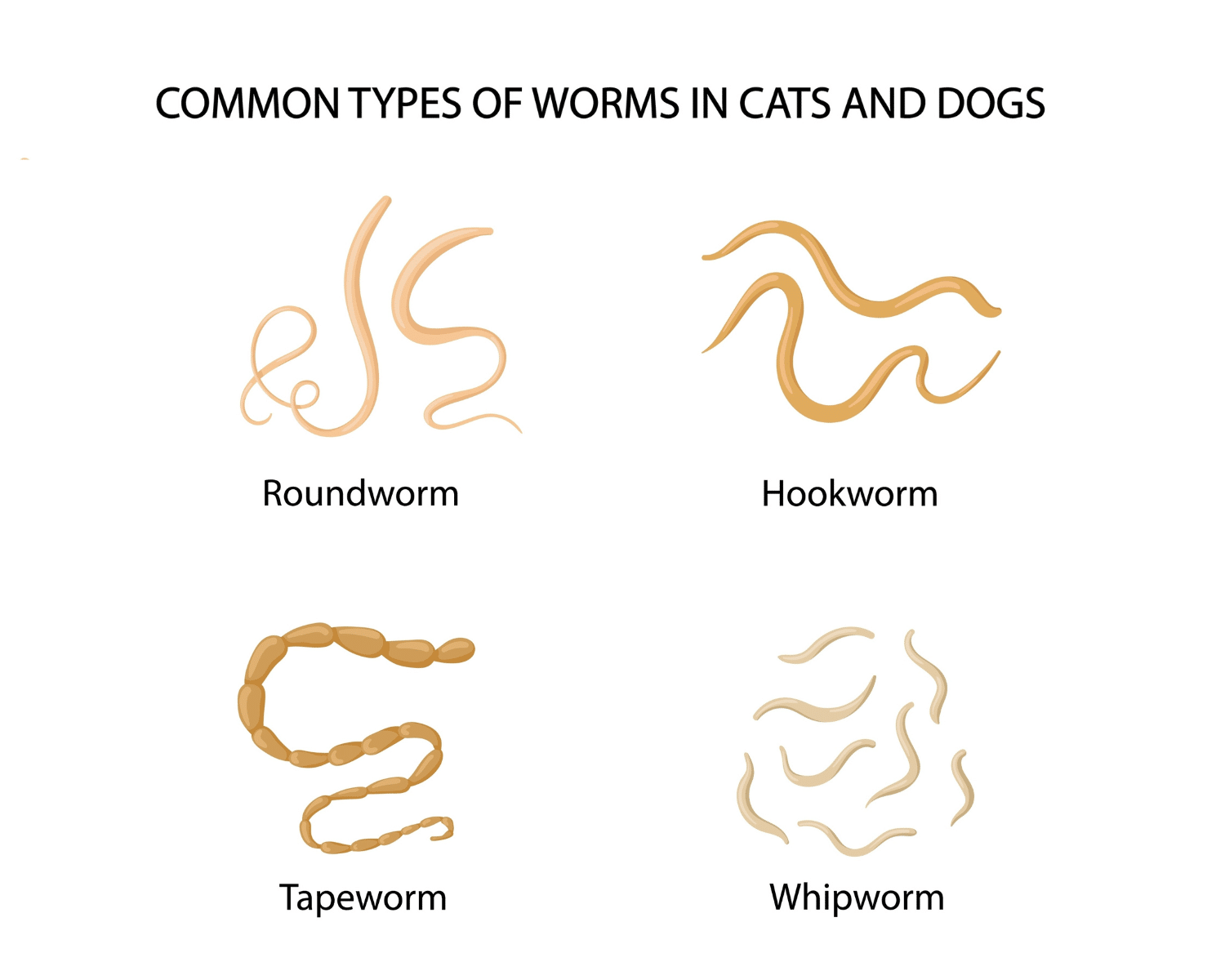Roundworms
What are roundworms?
Roundworms describe a many different worm parasites. The most common dog roundworm is Toxocara canis. Humans have a different roundworm, as do cats, horses, pigs, and other animals.
How does my dog get roundworms?
Dogs get roundworms either from eating worm eggs off the ground or because the mother dog was infected and passed the worms to her puppies during her pregnancy. Adult roundworms have funny faces, with three big lips surrounding their mouth. They feed on partially digested food in the dog’s intestine.
What are the risks?
Roundworms are a major health concern for your dog. Roundworms live in the small intestine of dogs. It is a microscopic and parasitic organism. Eggs are passed into the environment in the dog’s waste. The eggs then take two weeks to a month to become infective. There is no risk from fresh dog waste. However, after becoming infective, eggs can remain in the soil for several years.
The risk to humans is slight. Humans do not develop adult roundworms, although migration of larvae through tissues and organs can cause disease. Humans usually become infected through contact with eggs in the soil or by accidental ingestion.<
Direct contact between infected dogs and humans is not considered to play a role in the transmission of roundworm. Young children are at the greatest risk. They often eat dirt and grass and fill their mouths with contaminated hands. Hand-powered wheelchair users and field sports players also face greater risks.
How can roundworms be prevented?
Roundworm is not present in dogs that receive regular worm treatments. Picking up dog waste before roundworm eggs can become infective is equally important.
Hookworms
What are hookworms?
Hookworms are an intestinal parasite that feeds on blood. They have a direct life cycle meaning that they do not necessarily need a host to be transmitted. In pets, hookworm ova(egg) are passed in the host’s feces and develop to the first larval stage if the temperature and humidity are adequate. Ova can hatch in 10-12 hours at 30 degrees centigrade and in 9 hours at 37 degrees centigrade.
How does my dog get hookworms?
Infection can occur via ingestion or skin penetration (commonly infested through the feet) followed by a pulmonary migration, a developmental stage in the gastric glands, or an arrested state in the muscular tissue in older animals. Migration and maturation occur in 17 days. Transport hosts, especially rodents, may play a role in the transmission of this parasite.
What kind of problems do hookworms cause for dogs?
Young dogs and cats are affected more severely since they are less able to cope with depleted iron reserves.
Clinical signs may be one or more of the following: Intestinal blood loss causing anemia Bloody diarrhea Weight loss Poor hair coat
How are hookworm infections diagnosed?
A veterinarian diagnoses hookworms by fecal flotation. The ova are un-embryonated and must be taken from a fresh specimen since they hatch rapidly in warm weather. Therefore, unless you are going to the veterinarian quickly it is best to refrigerate stool samples or better yet have the vet extract the stool sample at their office. Your pet may not like that idea but it will yield the more accurate result.
How are hookworms treated?
There are many de-wormers available over-the-counter but they contain medications that are designed to “flush out” the parasite. But as the name implies, Hookworms hook onto the intestinal wall and “do not come off without a fight”. Many pets experience mild to severe distress because of these dewormers. These de-wormers were used by veterinarians decades ago, but veterinary medicine has come a long way since then.
Today, many anthelmintics are effective against hookworms in both dogs and cats. An aggressive treatment and prevention program as defined by your veterinarian normally entails two initial treatments 2 weeks apart (killing the hatched eggs and before they can hatch again and reproduce by administering a second dose), plus an aggressive preventive program. Since the medication can only kill what’s in the system monthly checkups for 3-4 months are needed until a pattern of negative test results is established. Because of the life-cycle of the hookworm, monthly combo preventative can help control but not usually eliminate the problem.
Also, it is extremely important to thoroughly clean and disinfect the affected areas. If this is not feasible walk your pet in a different area and if possible away from where other pets go. ALWAYS, pick up after your pet goes to the bathroom to minimize the chance of reinfection.
Are humans at risk?
Hookworms can pose a health hazard to humans, especially children.
It is imperative to keep on top of the situation and have your pet regularly tested. In humans, hookworms cause cutaneous larva migrans. The parasite can penetrate human skin and cause linear, tortuous, erythematous, and pruritic dermatitis (kids are more susceptible). Therefore, if you own a pet good hygiene, prevention, and management of stool area should be #1 on your list.

Tapeworms
What are tapeworms?
The most common tapeworm of dogs (and cats) is called Dipylidium caninum. This parasite attaches to the small intestinal wall by hook-like mouthparts. Adult tapeworms may reach 8 inches (20 cm) in length. The adult worm is actually made up of many small segments about 1/8 inch (3 mm) long. As the tail end of the worm matures, the terminal segments break off and pass into the stool. Occasionally, the mobile segments can be seen crawling near the anus or on the surface of a fresh bowel movement.
These segments look like grains of rice and contain tapeworm eggs; the eggs are released into the environment when the segment dries. The dried segments are small (about 1/16″, or 2 mm), hard, and golden in color. These dried segments can sometimes be seen stuck to the hair around the dog’s anus.
A less commonly found tapeworm, called Echinococcus, also occurs in dogs.
How does my dog get tapeworms?
In order for a dog to become infected with the common tapeworm, Dipylidium, the dog must swallow a flea that contains tapeworm eggs. This process begins when tapeworm eggs are swallowed by flea larvae (an immature stage of the flea). Contact between flea larvae and tapeworm eggs is thought to occur most frequently in contaminated bedding or carpet. Next, the dog chews or licks its skin as a flea bite; the flea is then swallowed. As the flea is digested within the dog’s intestine, the tapeworm hatches and anchors itself to the intestinal lining.
A dog becomes infected with Echinococcus when it eats a small mammal, usually a rodent, that contains the worm. Foxes and coyotes (and the wild rodents upon which they prey) are important in the life cycle of this parasite. Dogs and cats may also become infected if they eat rodents carrying the parasite.
What kind of problems do tapeworms cause for dogs?
Tapeworms are not highly pathogenic (harmful) to your dog. They may cause debilitation and weight loss when they occur in large numbers. Sometimes, the dog will scoot or drag its anus across the ground or carpet because the segments are irritating to the skin in this area. The adult worm is generally not seen, but the white segments that break away from the tapeworm and pass outside the body rarely fail to get an owner’s attention!
Occasionally, a tapeworm will release its attachment in the intestines and move into the stomach. This irritates the stomach, causing the dog to vomit the worm. When this happens, a worm several inches in length will be seen.
How is tapeworm infection diagnosed?
An infection with Dipylidium is usually diagnosed when the white, mobile segments are seen crawling on your dog or in the stool. Tapeworms are not usually detected by the routine fecal examination performed by the veterinarian. Because of this, veterinarians depend on the owner to notify them of possible tapeworm infection in the dog.
Echinococcus infections are harder to diagnose than the tapeworm caused by fleas because the segments are small and not readily seen.
How are the tapeworms treated?
Treatment is simple and, fortunately, very effective. A drug that kills tapeworms is given, either orally or by injection. It causes the tapeworm to dissolve within the intestines. Since the worm is usually digested before it passes, it is not visible in your dog’s stool. These drugs should not cause vomiting, diarrhea, or any other adverse side effects.
Control of fleas is very important in the management and prevention of tapeworm infection. Flea control involves the treatment of your dog, the indoor environment, and the outdoor environment where the dog resides. If the dog lives in a flea-infested environment, reinfection with tapeworms may occur in as little as two weeks. Because the medication that treats tapeworm infection is so effective, the return of the tapeworms is almost always due to reinfection from the environment.
How do I tell tapeworms from pinworms?
Tapeworms and pinworms look very similar. However, contrary to popular belief, pinworms do not infect dogs or cats. Any worm segments seen associated with dogs are due to tapeworms. Children who get pinworms do not get them from dogs or cats.
Echinococcus tapeworms are of more concern. These tapeworms cause very serious diseases when humans become infected. Hunters and trappers in the north-central United States and south-central Canada may be at risk for infection by this worm if strict hygiene is not observed. Rodent control and good hygiene are important in preventing the spread of this disease to humans. As with the more common tapeworm, infection with Echinococcus is infrequent but possible.
What can be done to control tapeworm infection in dogs and to prevent human infection?
Effective flea control is important. Prompt deworming should be given when parasites are detected; periodic deworming may be appropriate for pets at high risk for reinfection. All pet feces should be disposed of promptly, especially in yards, playgrounds, and public parks. Do not allow children to play in potentially contaminated environments. Strict hygiene is important, especially for children.
Whipworms
What are whipworms?
Whipworms are intestinal parasites which are about 1/4 inch (6 mm) long. They live in the cecum and colon of dogs where they cause severe irritation to the lining of those organs. This results in watery, bloody diarrhea, weight loss, and general debilitation. They are one of the most pathogenic worms found in dogs.
How does my dog get whipworms?
Whipworms pass microscopic eggs in the stool. The eggs are very resistant to drying and heat, so they can remain viable in the dog’s environment for years. They mature and are able to re-infect the dog in 10-60 days. The eggs are swallowed and return to the lower intestinal tract to complete the life cycle.
How is whipworm infection diagnosed?
Whipworms are diagnosed by finding eggs with a microscopic examination of the stool. However, multiple samples are often required because these parasites pass small numbers of eggs on an irregular basis. Any dog with chronic diarrhea can be reasonably suspected to have whipworms, regardless of several negative stool examinations. It is an accepted practice to treat whipworms based on the assumption of infection. Response to treatment is an indication that whipworms were present but could not be detected on fecal examination.
How are whipworms treated?
There are several drugs that are very effective against whipworms. Two treatments are needed at a 3-4 week interval, but because reinfection is such a problem, it is advisable to treat again every 3-4 months or to put the dog on a heartworm prevention product that contains an ingredient that prevents infection with whipworms. Whipworms are not nearly as common now because of the widespread use of these types of heartworm prevention products.
Can I get whipworms from my dog?
No. Whipworms are not infectious to people; they are parasites of the dog.

